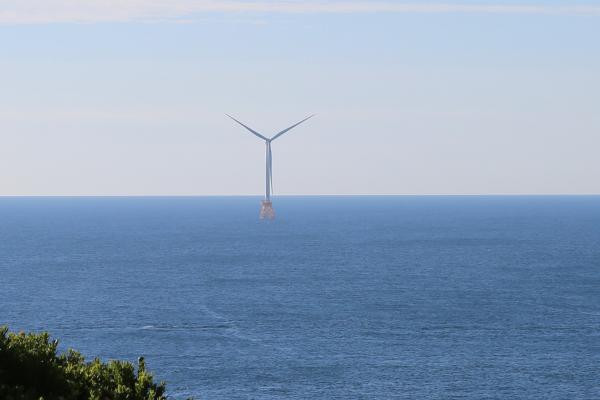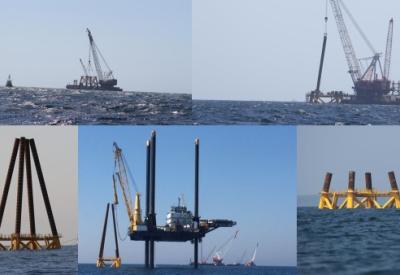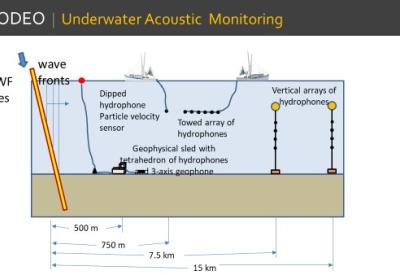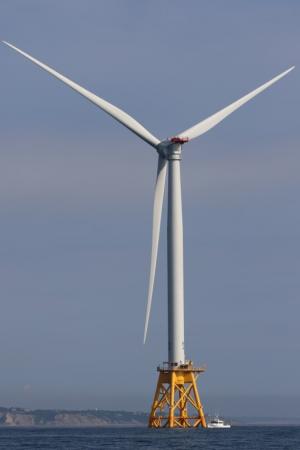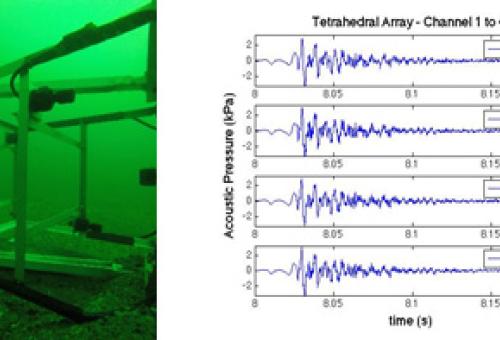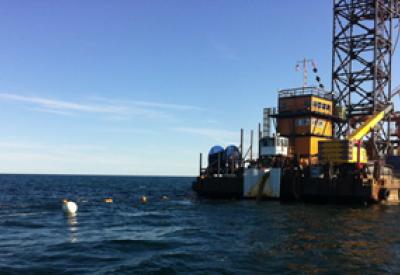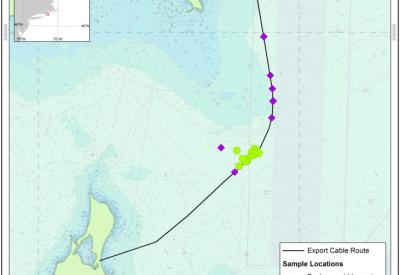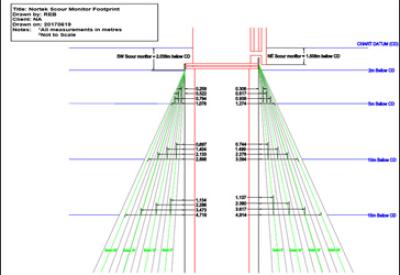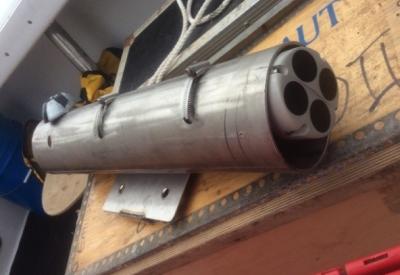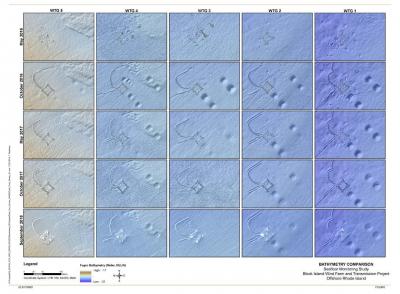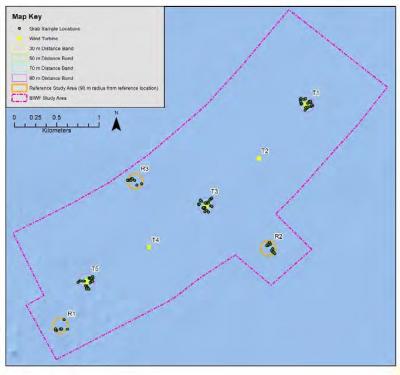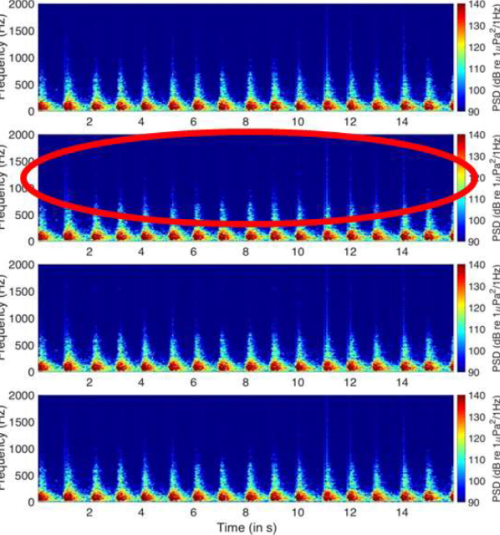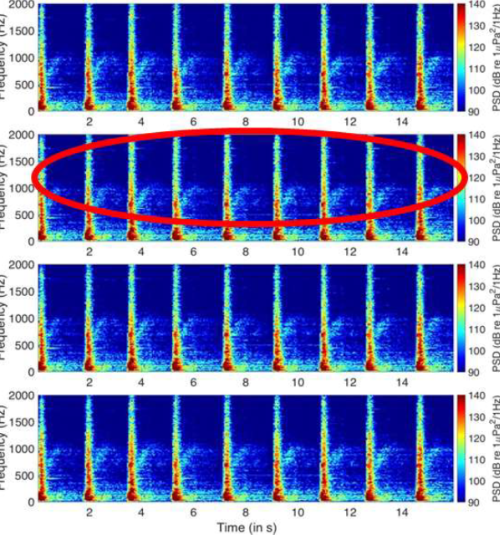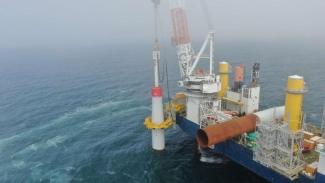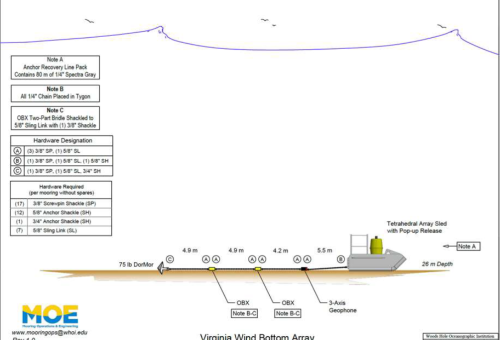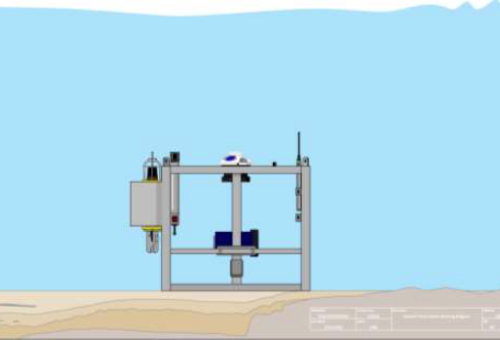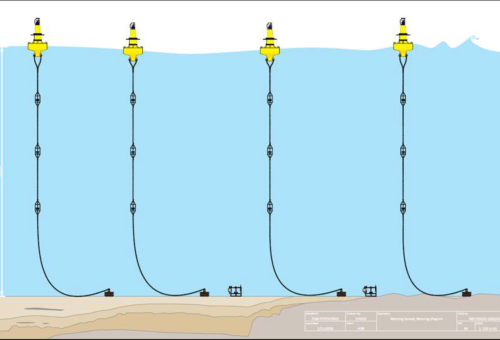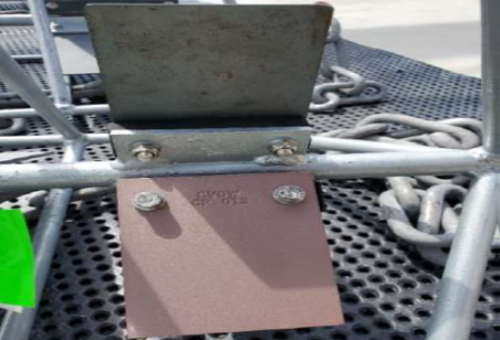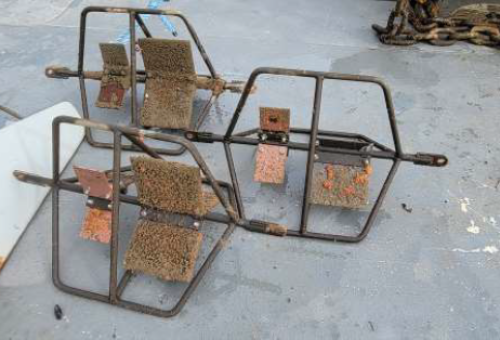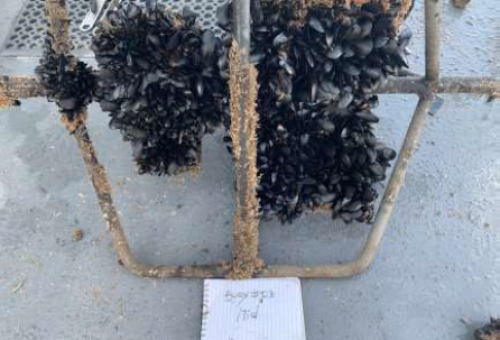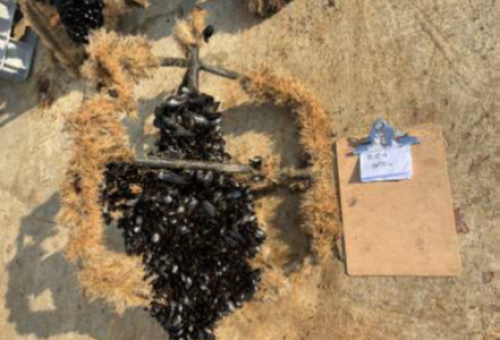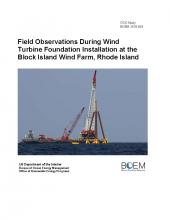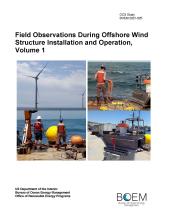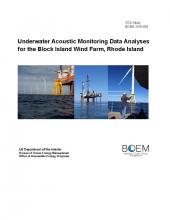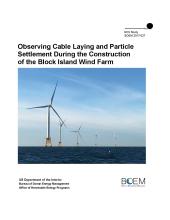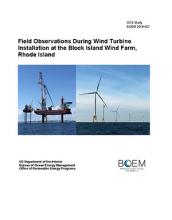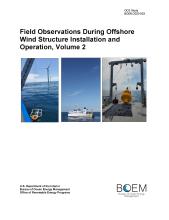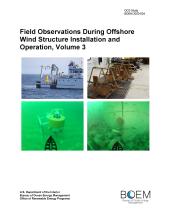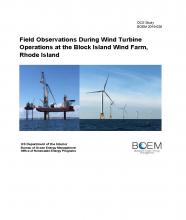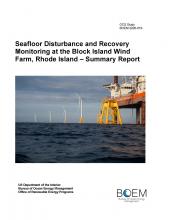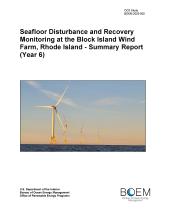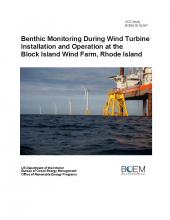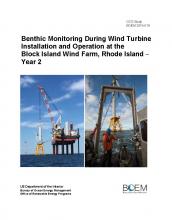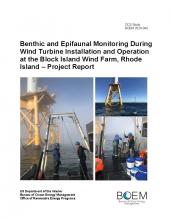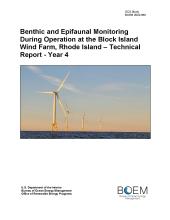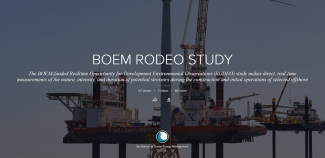The purpose of the study Realtime Opportunity for Development Environmental Observations (RODEO) is to make direct, real-time measurements of the nature, intensity, and duration of potential stressors during the construction and initial operations of selected offshore wind facilities. The purpose also includes recording direct observations during the testing of different types of equipment or methods that may be used during future offshore development to measure or monitor activities and their impact producing factors.
Data collected under RODEO may be used as input to analyses or models to predict effects from future offshore wind farm construction and operation activities. However, these efforts will not duplicate or substitute for any monitoring that may otherwise be required to be conducted by the developers of the projects. RODEO monitoring is coordinated with the industry and is not intended to interfere with or result in delay of industry activities.
The Block Island Wind Farm (BIWF) is the first facility to be studied under RODEO. Observations were made during the installation of the wind turbine foundations, the installation of the turbine towers, and during early operations. During installation, a record of the types and duration of activities was maintained. Sound from pile driving was recorded at distances near the construction (500 m) and far from construction (15 km and beyond).
The Coastal Virginia Offshore Wind Pilot Project (CVOW) is the second location where offshore wind turbines were constructed. Two monopile foundations were installed in May 2020. The RODEO team deployed and recovered equipment to measure the sound produced during pile driving. The sound from the installation of one turbine was dampened by the use of a bubble curtain. The second foundation was installed without the bubble curtain. Results are compared to determine the level of reduction in the sound intensity through the use of a bubble curtain. Operational sound was also monitored at the site.
Please review the Publications tab for all of the activities conducted.
Pile Driving Sound
Monitoring was conducted at BIWF during the installation of the wind turbine foundations in the summer and fall of 2015 for near- and far-field underwater sound. Results from data analyses show that pile driving sound was above background sound levels at ranges in excess of 20 km (12.4 mi).
Because the piles were installed at an angle, the sound varied by 10 decibals depending on the location. Read more about the observations here: Field Observations during Wind Turbine Foundation Installation at the Block Island Wind Farm, Rhode Island
Operational Sound
Underwater acoustic signals were measured during winter (20 December 2016 to 7 January 2017) and late summer (2 October to 3 November 2017) conditions. In addition, extended underwater acoustic monitoring also was conducted over 100 days during summer 2017 (15 July to 24 October 2017). Underwater sound at 50 meters from the turbine were near background levels and often not measurable due to other natural and anthropogenic noise (waves or boat sounds). Read more about the results here: Field Observations During Wind Turbine Operations at the Block Island Wind Farm, Rhode Island
Particle Motion
Particle motion was measured during pile driving using a sled with hydrophones positioned in a tetrahedral configuration. Results from acoustic monitoring during pile driving indicated that at 500 m from the foundation, fish would likely be able to detect particle velocities in the frequency range of 30-300 Hertz and that this was more pronounced on the seabed than in the water column. Sound pressure levels at 500 m did not exceed ANSI-accredited injury thresholds. However, behavioral thresholds for fish were exceeded within 500 m of the foundations but not at stations 20 km and 30 km from the foundations. Read more about particle motion here: Underwater Acoustic Monitoring Data Analyses for the Block Island Wind Farm, Rhode Island
Cable Laying
An export cable was installed between the mainland of Rhode Island and Block Island. Approximately 20 miles of cable was layed over 24 days in June of 2016. Suspended sediment and sediment deposition from cable laying averaged around 1mg/l at the surface to < 9mg/l on the seafloor for suspended sediment. Deposition was observed up to 3.8 m from the trench with an average thickness of 7 cm. Read more about the results here: Observing Cable Laying and Particle Settlement During the Construction of the Block Island Wind Farm
Scour Monitoring
Two scour monitors were installed on Turbine #3 and in place for 16 months. Data was continuously collected for the time period. The seafloor was observed to fluctuate in level by several centimeters which correlated with storm conditions. Read more about the results in: Field Observations during Wind Turbine Foundation Installation at the Block Island Wind Farm, Rhode Island
Seafloor Disturbance and Recovery
Seafloor disturbance and recovery monitoring was conducted in and around the Block Island Wind Farm (BIWF) to assess the impact of wind farm construction activities on the seafloor. Previous studies from Europe have shown that introduction of solid structures onto the seafloor, such as the four-legged BIWF turbine jacket foundations, can modify near-bottom current flow processes and induce scour. Five rounds of seafloor bathymetry surveys were conducted within a defined construction Work Area from a small research vessel using a Reson SeaBat 7125 ultra-high-resolution multibeam echosounder. Seafloor bathymetry data from the first and second surveys were primarily used to characterize the different types of seafloor disturbance features that resulted from construction activities. Data from the three rounds of post-construction surveys were used to evaluate the rate of seafloor recovery. Read more about the results in: Seafloor disturbance and Recovery Monitoring at the Block Island Wind Farm, Rhode Island - Summary Report
Benthic Habitat Changes
Studies looking at benthic changes at BIWF found that the changes occurred along a geospatial gradient ranging from minimal changes to transitioning to habitat with entirely different characteristics than existed prior to construction. The transformed habitat was characterized by dense mussels, high organic content, and fine sediment. However, the study also showed that benthic changes may be highly site-specific even within a single wind facility. Read more about the results here: Benthic and Epifaunal Monitoring During Wind Turbine Installation and Operation at the Block Island Wind Farm, Rhode Island – Project Report
Epifouling on the Turbines
From the moment the turbines were installed, marine life began to cover the hard surfaces. Primarily, the inhabitants are mussels, but many other sea creatures are making their home on the turbines including sea stars and anemones. Watch the video.
Fish around the Turbines
While the divers were exploring the marine life attached to the turbine structure, they also ventured away to see the fish. Watch the video.
Other Studies at Block Island Wind Farm
In addition to collaboration with ocean users in the siting of the facility, the BIWF has also provided the opportunity to study the impacts of offshore wind development to fishery resources. Observations were made through BOEM and developer-funded studies before and during the installation of the foundations, turbines, and during early operations. Interestingly, the studies at BIWF showed that some concrete cable protection measures did not provide niches for attaching epifauna and epiflora and thus provide no habitat benefit. Lastly, studies of flatfish occurrence at BIWF found spatial and temporal variation in abundance, size, and condition, but this variation was not consistent with either positive or negative effects of wind farm construction or operation. Lower winter flounder abundances during the pile-driving time period and higher abundances during the cable-laying time period in the reference and wind farm areas suggest regionwide population fluctuations occurred. Although noise from pile driving may have been detectable in the reference areas, other flatfish abundances were not lower during this time period. Although no artificial reef effect was found for flatfish, negative impacts from construction activity and wind farm operation also were not evident (reference to Wilber et al 2018 Journal of Sea Research).
Pile Driving Sound
The sound field was monitored during the installation of the two turbines at the Coastal Virginia Offshore Wind Pilot Project. One turbine was installed using a double bubble curtain to reduce the sound levels in the underwater environment. The second turbine was installed without the bubble curtain for comparison purposes.
The sound levels were reduced by the bubble curtain between 11 and 23 decibels, depending on distance and sound frequency.
Operational Sound
Operational sound was measured between Dec. 14, 2021, and Feb. 2, 2022, using a Geosled equipped with a tetrahedral hydrophone array and two Several Hydrophone Recording Units (SHRU). Additionally, two Ocean Bottom Seismometers were deployed.
Underwater noise levels recorded during turbine operations were relatively low, ranging from 120 to 130 dB re 1 μPa except during storms when the received levels increased to 145 dB re 1 μPa. Operational phase sound levels were substantially higher (10 to 30 dB) than those previously recorded at the Block Island Wind Farm (BIWF) at frequencies below approximately 120 Hz.
Turbidity
Over a 19-month period, wave and current data were collected to evaluate sediment suspension (turbidity) from the presence of the turbines. The turbidity was generally low with an average less than10 milligrams per liter.
Corrosion
Corrosion coupons were deployed on moorings and recovered every three months during the two-year period. Plates were both treated and untreated to evaluate the use of a coating. Corrosion of the untreated coupon was observed and exceeded industry standards. The coating prevented corrosion but there was pitting where marine biota had attached.
Biofouling
Plates were deployed on the mooring to evaluate the rates of biofouling and the types of marine biota that colonized. Initial colonizers include hydroids (Obelia sp.), Tubulariidae (Ectopleura larynx), or Jassa marmorata (as amphipod mat) together with caprellid (skeleton shrimp [Caprella equilibra] and barnacles (Amphibalanus amphitrite and Chelonibia sp). Stalked barnacles (Lepas anatifera and Conchoderma auritum) also appeared quickly on settlement plates. Mussel (Mytilus sp.) communities formed after around 1 year. Growth on the turbines mimicked the observations on the biofouling plates.
Many fish were observed around the monopile structure.
Report | Contents | |
Installing Foundations | ||
| Field Observations during Wind Turbine Foundation Installation at the Block Island Wind Farm, Rhode Island |
| |
| Field Observations During Offshore Wind Structure Installation and Operation, Volume I |
| |
| Underwater Acoustic Monitoring Data Analyses for the Block Island Wind Farm, Rhode Island |
| |
Cable Laying | ||
| Observing Cable Laying and Particle Settlement During the Construction of the Block Island Wind Farm |
| |
Installing Wind Turbines | ||
| Field Observations During Wind Turbine Installation at the Block Island Wind Farm, Rhode Island |
| |
Operating Wind Turbines | ||
| Field Observations During Offshore Wind Structure Installation and Operation, Volume 2 |
| |
| Field Observations During Offshore Wind Structure Installation and Operation, Volume 3 |
| |
| Field Observations During Wind Turbine Operations at the Block Island Wind Farm, Rhode Island |
| |
| Seafloor Disturbance and Recovery Monitoring at the Block Island Wind Farm, Rhode Island – Summary Report |
| |
| Seafloor Disturbance and Recovery Monitoring at the Block Island Wind Farm, Rhode Island - Summary Report (Year 6) |
| |
Benthic Monitoring | ||
| Benthic Monitoring During Wind Turbine Installation and Operation at the Block Island Wind Farm, Rhode Island |
| |
| Benthic Monitoring During Wind Turbine Installation and Operation at the Block Island Wind Farm, Rhode Island – Year 2 |
| |
| Benthic and Epifaunal Monitoring During Wind Turbine Installation and Operation at the Block Island Wind Farm (BIWF), Rhode Island – Project Report |
| |
| Benthic and Epifaunal Monitoring During Operation at the Block Island Wind Farm, Rhode Island – Technical Report - Year 4 |
| |
See BOEM’s Flickr Album: https://www.flickr.com/photos/boemgov/albums/72177720309225393
RODEO Program, Block Island Wind Farm Real-Time Environmental Monitoring
List of Reports, Publications, and Presentations
Updated: June 2023
Project Reports:
- Elliott J, Smith K, Gallien DR, Khan A. 2017. Observing cable laying and particle settlement during the construction of the Block Island Wind Farm. Final Report to the U.S. Department of the Interior, Bureau of Ocean Energy Management, Office of Renewable Energy Programs. OCS Study BOEM 2017-027. 225 pp.
- HDR. 2018. Scour monitoring at the Block Island Wind Farm, Rhode Island. Final Report to the U.S. Department of the Interior, Bureau of Ocean Energy Management, Office of Renewable Energy Programs. OCS Study BOEM 2018. 25 pp.
- HDR. 2018. Field observations during wind turbine foundation installation at the Block Island Wind Farm, Rhode Island. Final Report to the U.S. Department of the Interior, Bureau of Ocean Energy Management, Office of Renewable Energy Programs. OCS Study BOEM 2018-029. 175 pp.
- HDR. 2018. Benthic monitoring during wind turbine installation and operation at the Block Island Wind Farm, Rhode Island. Final Report to the U.S. Department of the Interior, Bureau of Ocean Energy Management, Office of Renewable Energy Programs. OCS Study BOEM 2018-047. 155 pp.
- HDR. 2019. Benthic monitoring during wind turbine installation and operation at the Block Island Wind Farm, Rhode Island – Year 2. Final Report to the U.S. Department of the Interior, Bureau of Ocean Energy Management, Office of Renewable Energy Programs. OCS Study BOEM 2019-019. 318 pp.
- HDR. 2019. Field observations during wind turbine installation at the Block Island Wind Farm, Rhode Island. Final Report to the U.S. Department of the Interior, Bureau of Ocean Energy Management, Office of Renewable Energy Programs. OCS Study BOEM 2019-027. 292 pp.
- HDR. 2019. Field observations during wind turbine operations at the Block Island Wind Farm, Rhode Island. Final Report to the U.S. Department of the Interior, Bureau of Ocean Energy Management, Office of Renewable Energy Programs. OCS Study BOEM 2019-028. 281 pp.
- HDR. 2019. Underwater acoustic monitoring data analyses for the Block Island Wind Farm, Rhode Island. Final Report to the U.S. Department of the Interior, Bureau of Ocean Energy Management, Office of Renewable Energy Programs. OCS Study BOEM 2019-029. 110pp.
- HDR. 2020. Seafloor disturbance and recovery monitoring at the Block Island Wind Farm, Rhode Island – Summary Report. Final Report to the U.S. Department of the Interior, Bureau of Ocean Energy Management, Office of Renewable Energy Programs. OCS Study BOEM 2020-019. 65 pp.
- HDR. 2020. Benthic and epifaunal monitoring during wind turbine installation and operation at the Block Island Wind Farm, Rhode Island – Project Report. Final Report to the U.S. Department of the Interior, Bureau of Ocean Energy Management, Office of Renewable Energy Programs. OCS Study BOEM 2020-044. Volume 1: 263 pp; Volume 2:380 pp.
- HDR. 2020. Field Observations During Offshore Wind Structure Installation and Operation, Volume I. Final Report to the U.S. Department of the Interior, Bureau of Ocean Energy Management, Office of Renewable Energy Programs. Contract No. M15PC00002. Report No. OCS Study BOEM 2021-225. 332 pp.
- HDR. 2023. Field Observations During Offshore Wind Structure Installation and Operation, Volume 2. Final Report to U.S. Department of the Interior, Bureau of Ocean Energy Management, Office of Renewable Energy Programs. Contract No. M15PC00002. Report No. OCS Study BOEM 2023-033, pp 48.
- HDR. 2023. Field Observations During Offshore Wind Structure Installation and Operation, Volume 3. Final Report to the U.S. Department of the Interior, Bureau of Ocean Energy Management, Office of Renewable Energy Programs. Contract No. M15PC00002. Report No. OCS Study BOEM 2023-034. 224 pp
Peer-reviewed Publications:
- Mason T, Gallen D, Khan A. 2016. Validation of existing guidance for airborne noise transmission over water during offshore wind farm construction. Proceedings of the Institute of Acoustics. 38, Pt 3.
- Potty GR, Miller JH. 2018. Shear wave inversion using horizontal to vertical ratio of Scholte wave particle velocity. Proceedings of the IEEE-OES OCEANS meeting, Charleston, October 22-25, 2018.
- Ragusa AF, Miller JH, Potty GR. 2018. Finite element modeling of Rayleigh wave propagation in a laboratory facility. The Journal of the Acoustical Society of America. 143:1726; https://doi.org/10.1121/1.5035626.
- Lin YT, Newhall AE, Miller J, Potty GR, and Vigness-Raposa K. 2019. A three-dimensional underwater sound propagation model for offshore wind farm noise prediction. JASA Express Letters 145(5): EL335–EL340; https://doi.org/10.1121/1.5099560.
- Potty GR, Miller JH, Lin YT, Newhall AE, Vigness-Raposa K. 2019. Estimation of geophone orientation using source of opportunity. 2019 International Symposium on Ocean Technology (SYMPOL), Ernakulam, India, December 2019, pp. 3–9; https://doi.org/10.1109/SYMPOL48207.2019.9005302.
- Amaral JL, Miller JH, Potty GR, Vigness-Raposa K, Frankel AS, et al. 2020. Characterization of impact pile driving signals during installation of offshore wind turbine foundations. The Journal of the Acoustical Society of America. 147(4):2323–2333; https://doi.org/10.1121/10.0001035.
- Potty, G.R., Miller, J.H., Lin, YT., Vigness-Raposa, K. 2023. Interface Wave Contribution to Acoustic Particle Motion During Offshore Wind Farm Construction. In: Popper, A.N., Sisneros, J., Hawkins, A.D., Thomsen, F. (eds) The Effects of Noise on Aquatic Life . Springer, Cham. https://doi.org/10.1007/978-3-031-10417-6_126-1.
- Hutchison ZL, Bartley ML, Degraer S, English P, Khan A, Livermore J, Rumes B, King JW. 2020. Offshore wind energy and benthic habitat changes; lessons from Block Island Wind Farm, USA. Wind Energy Special Issue – Oceanography.
- Miller et al. Turbine noise mechanisms, air-water propagation, wind speed, power production. JASA, in progress).
- Potty GR, et al. Compute particle velocity using tetrahedral array and other sensors for fish studies. JASA-EL, in progress.
Conference/Workshop Presentations:
- Miller JH, Potty GR, King JW, Gallien DR, Khan A, Elliot J, Vigness-Raposa K, Giard JL, Frankel AS, Mason T, Popper AN, Hawkins AD, Crocker SE, Lin YT, Newhall A, Baumgartner M. 2016. Acoustic and seismic measurements of pile driving for the first offshore wind farm in the United States, The Fourth International Conference on The Effects of Noise on Aquatic Life, Dublin, Ireland, July 10-16, 2016.
- Miller JH, Potty GR, King JW, Gallien DR, Khan AA, Elliot J, Vigness-Raposa K, Giard JL, Frankel AS, Mason T, Popper AN, Hawkins AD, Crocker SE, Lin YT, Newhall A, Baumgartner M. 2016. Lessons learned from monitoring the environmental effects of construction of the first offshore wind farm in the US. Presented at Fourth International Conference on the Effects of Noise on Aquatic Life, Dublin, Ireland, July 10-15, 2016.
- Khan A, Elliot J, Gallien G. 2016. Overview of BOEM’s real-time opportunity for development of environmental observations (RODEO) program. Atlantic Ocean Energy and Mineral Science Forum, Bureau of Ocean Energy and Management, Washington, DC, October 2016.
- Miller J. 2016. RODEO program – aerial and underwater acoustic monitoring. Atlantic Ocean Energy and Mineral Science Forum, Bureau of Ocean Energy and Management, Washington, DC, October 2016.
- Smith S. 2016. RODEO program – sediment disturbance and seafloor recovery monitoring. Atlantic Ocean Energy and Mineral Science Forum, Bureau of Ocean Energy and Management, Washington, DC, October 2016.
- Mason T, Gallien D, Khan A. 2016. Validation of existing guidance for airborne noise transmission over water during offshore wind farm construction. Proceedings of the Institute of Acoustics Conference, University of Cambridge, Cambridge, UK, December 2016.
- Newhall AE, Lin YT, Miller JF, Potty GR, Vigness-Raposa K, Frankel A, Giard JL, Gallien DR, Elliot J, Mason T. 2016. Monitoring the acoustic effects of pile driving for the first offshore wind farm in the United States. The Journal of the Acoustical Society of America. 139:2181.
- Giard JL, Miller JH, Potty GR, Newhall A, Lin YT, Baumgartner MF. 2017. Analysis of fin whale vocalizations south of Rhode Island. The Journal of the Acoustical Society of America. 141:3941; doi: http://dx.doi.org/10.1121/1.4988927. 3rd Joint Meeting of the Acoustical Society of America and the European Acoustics Association, Boston, MA, June 25-29, 2017.
- Lin YT, Newhall A, Potty GR, Miller JH. 2017. A preliminary numerical model of three-dimensional underwater sound propagation in the Block Island Wind Farm area. The Journal of the Acoustical Society of America. 141:3993; doi: http://dx.doi.org/10.1121/1.4989146. Presented at the 3rd Joint Meeting of the Acoustical Society of America and the European Acoustics Association, Boston, MA, June 25-29, 2017.
- Miller JH, Potty GR, Lin YT, Newhall A, Vigness-Raposa K, Amaral JL, Mason T. 2017. Overview of underwater acoustic and seismic measurements of the construction and operation of the Block Island Wind Farm. Presented at the 3rd Joint Meeting of the Acoustical Society of America and the European Acoustics Association, Boston, MA, June 25–29, 2017.
- Potty GR, Tazawa M, Giard J, Miller JH, Lin YT, Newhall A, Vigness-Raposa KJ. 2017. Measurements of particle motion near the seafloor during construction and operation of the Block Island Wind Farm. The Journal of the Acoustical Society of America. 141:3993; doi: http://dx.doi.org/10.1121/1.4989145. Presented at the 3rd Joint Meeting of the Acoustical Society of America and the European Acoustics Association, Boston, MA, June 25-29, 2017.
- Ragusa AF, Potty GR, Miller JH, Lin YT, Newhall A, Vigness-Raposa KJ, Giard J, Ross M, Roberts J. 2017. 3D acoustic propagation modeling of the construction of the Block Island Wind Farm. The Journal of the Acoustical Society of America. 141:3533; doi: http://dx.doi.org/10.1121/1.4987465. 3rd Joint Meeting of the Acoustical Society of America and the European Acoustics Association, Boston, MA, June 25-29, 2017.
- Vigness-Raposa KJ, Giard J, Frankel AS, Miller JH, Potty GR, Lin YT, Newhall A, Mason T. 2017. Variations in the acoustic field recorded during pile-driving construction of the Block Island Wind Farm. The Journal of the Acoustical Society of America. 141: 3993; doi: http://dx.doi.org/10.1121/1.4989147. Presented at the 3rd Joint Meeting of the Acoustical Society of America and the European Acoustics Association, Boston, MA, June 25-29, 2017.
- Potty GR, Miller JH, Lin YT, Newhall A, Vigness-Raposa K, Amaral J, Mason T. 2017. Acoustics and particle velocity monitoring. Atlantic Offshore Renewable Energy Development and Fisheries Workshop, National Academies of Sciences, Engineering and Medicine, November 8 and 9, 2017.
- Miller JH, Potty GR, Lin YT, Newhall A, Vigness-Raposa K, Amaral JL, Mason T. 2017. Overview of underwater acoustic and seismic measurements of the construction and operation of the Block Island Wind Farm. IEEE Oceanic Engineering Society Providence Chapter.
- Miller JH, Potty GR, Lin YT, Newhall AE, Vigness-Raposa KJ, Giard J, Mason T. 2018. Measurements of underwater sound radiated from an offshore wind turbine. The Journal of the Acoustical Society of America. 142:2699. Presented at the 174th Meeting of the Acoustical Society of America, Minneapolis, MN, May 2018.
- Lin YT. 2018. Study of three-dimensional underwater sound propagation in the Block Island Wind Farm area. OCEANS Meeting Special Session, Charleston, SC, October 22–25, 2018.
- Miller JH. 2018. Overview of underwater acoustic and seismic measurements of the construction and operation of the Block Island Wind Farm. OCEANS Meeting Special Session, Charleston, SC, October 22–25, 2018.
- Potty GR. 2018. Measurements of particle motion near the seafloor during construction and operation of the Block Island Wind Farm. OCEANS Meeting Special Session, Charleston, SC, October 22–25, 2018.
- Vigness-Raposa KJ. 2018. Variations in the underwater acoustic field during pile-driving construction influence the exposure of marine mammals. OCEANS Meeting Special Session, Charleston, SC, October 22–25, 2018.
- Miller JH, Potty GR, Tripathy A, Tazawa M, Amaral J, Vigness-Raposa K, Lin YT, Newhall A. 2018. Source localization using a compact tetrahedral array. Presented at the Acoustical Society of America Meeting, Victoria, BC, November 2018.
- Amaral JL, Miller JH, Potty GR, Vigness-Raposa KJ, Lin YT, Frankel AS, Newhall AE. 2019. Characterization of an impulsive pile driving signal with range during installation of offshore wind turbines. Presented at the Effects on Noise on Aquatic Life Conference, Den Haag, Netherlands, July 7-12, 2019.
- Amaral JL, Frankel AS, Miller JH, Potty GR, Lin YT, Newhall A. 2020. Bubble curtain effectiveness during impact pile driving for monopile installation at the Coastal Virginia Offshore Wind project. Presented at the Acoustical Society of America Virtual Meeting.
- Hutchison Z, Bartley ML, King J, English P, Khan A. 2020. Near-field spatial and temporal benthic monitoring at the Block Island Wind Farm, USA. Presented at the Ocean Sciences Meeting San Diego, February 21, 2020.
- Amaral JL, Miller JH, Potty GR, Vigness-Raposa KJ, Lin YT, Newhall A. 2020. Underwater Sounds of Offshore Wind Farms. Presented at the Baird Sea Grant Science Symposium. July 21, 2020.
- Bartley ML, Hutchison ZL, King J, English P, Grace S, Khan A. 2020. Benthic and Epifaunal Monitoring at the Block Island Wind Farm, Rhode Island, USA. Presented at the Baird Sea Grant Science Symposium, July 21, 2020.
- Ampela K, Khan A. 2020. BOEM’S RODEO program overview. Presented at the International Partnering Forum Virtual Meeting, August 2020.
- Potty GR, Miller JH, Lin YT, Newhall AE, Vigness-Raposa K. 2020. Characterization of seismic noise near Offshore Wind Farm sites in the United States East Coast. Presented at the International Conference on Underwater Acoustics Virtual Conference, September 9, 2020.
- Potty GR, Miller JH, Lin YT, Newhall AE, Vigness-Raposa K. 2020. Characterization of seismic noise at two shallow water sites in the United States East Coast. Presented at the Global OCEANS Virtual Conference, October 2020.
- Hutchison Z, Bartley ML, King J, English P, Khan A. 2020. Benthic and biofouling monitoring at the Block Island Wind Farm. Presented at the State of the Science Virtual Workshop, November 2020.
- Amaral, J., Miller, J., Potty, G., Lin, Y.-T., Vigness-Raposa, K. 2021. Fin whale localization and environmental inversion using modal arrivals of the 20-Hz pulse. Presented at the Acoustical Society of America Meeting, Seattle, WA, November-December 2021.
- Amaral, J., Miller, J., Potty, G., Vigness-Raposa, K., Lin, Y-T, Frankel, A., Newhall, A., Wilkes, D., Gavrilov, A. 2022. Analysis of underwater sounds from impact pile driving at the Block Island Wind Farm. Presented at the Acoustical Society of America Meeting, Denver, CO, May 2022.
- Y.-T. Lin, A.E. Newhall, J.H. Miller, G.R. Potty, J.L. Amaral, A.S. Frankel, T.I. Mason, K. Ampela, and A.A. Khan, “Passive acoustic monitoring during the construction of the Coastal Virginia Offshore Wind project,” J. Acoust. Soc. Am., vol. 151, A239.


